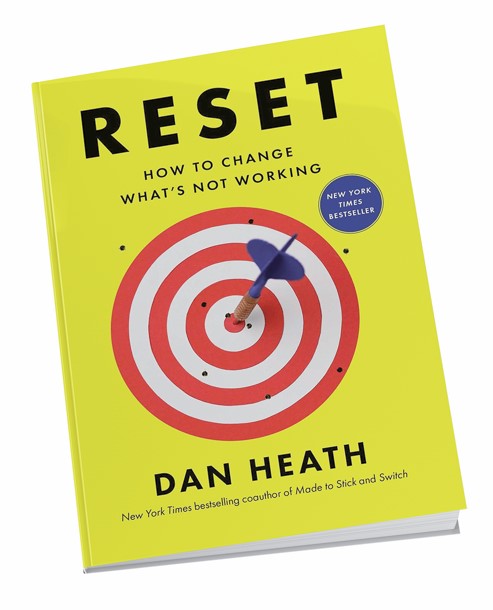
REVIEWED BY RENEE HOPKINS
Qualitative Researcher
Numerator
Chicago, Illinois
renee.hopkins@numerator.com
Dan Heath’s Reset: How to Change What’s Not Working is the business book qualitative researchers need though they probably don’t realize it. I certainly didn’t realize it before I read it. But before I finished the first chapter it was clear to me that the book’s main point—how to create a roadmap for teams to fix the internal systems that hold them back—can be applied to both the insights qualitative researchers offer their clients and to the business of qualitative research itself.
Reset is the fifth book by Dan Heath since he co-wrote 2007’s Made to Stick: Why Some Ideas Thrive and Others Die with his brother Chip Heath. Made to Stick was a huge success that the Heath brothers (together and separately) followed with four other business books, each of which also features a catchy title, and a pithy, central idea illustrated with concrete examples and clearly stated actionable business insights, which could also be applied to your personal life. I was skeptical about Reset because it seems unlikely to write one good book with business insights so actionable that some could also function as personal self-help—let alone five such books. Yet Reset meets the challenge.
Reset focuses on “change” in the biggest sense of the word—large-scale, organizational change. This kind of change is a complex, iterative process of identifying “symptoms” and ways to solve them. First, one must understand what a “problem” actually is. For Heath, an inability to grow your business or the loss of existing business are not problems—they are symptoms. What makes change complex is that there is almost always more than one problem underlying a set of symptoms. But there is usually just one underlying problem so critical that fixing it could radically improve the whole set of symptoms. To solve that critical, underlying problem, you don’t need to fix all of the symptoms—just the ones that are causing the critical, underlying problem. Then you must identify the actions that will address that problem.
Clearly, there’s a lot that can go wrong here. Think of it like the “check engine” light in your car. When it’s on, you can fix many different symptoms, but not all of these fixes will actually address the problem that caused the check engine light to come on. The mechanic has to find the actual problem underlying the symptoms, which can take a while—to the detriment of our pocketbooks.
Our clients often come to us because they see problems (which Heath would call “symptoms”) such as a decline in sales or the need to increase sales. They feel qualitative research insights will help them identify pain points and explore solutions. Of course, we can help clients solve their problems. But if we look at our clients’ problems through the Reset lens as symptoms, our qualitative insights can help clients identify the critical problem that is most likely underlying the entire set of symptoms. Heath calls this the “leverage point”—the symptom that, if fixed, can “yield a disproportionate return” because that fix helps uncover the critical, underlying problem.
Heath’s first step is, essentially, qualitative research, which he describes as “go and see the work.” For example, talk to the employees; watch how they interact with customers or their co-workers. What are those who get the best results doing? How is it different from what others do? This helps clients understand what Heath calls “waste”—efforts that don’t “serve the mission,” that are inefficient, and that aren’t a good use of human resources or materials.
With these insights, clients can understand the most critical point where the process slows down or breaks down. They can begin to identify answers to what Heath considers the central question: what can be reset that will bring about positive change? In my own words, how can they reset their business’ check engine light?
With the advent of artificial intelligence (AI), qualitative researchers have begun to realize they need to “level up” their services. We can design qualitative research to uncover the kind of essential insights Reset shows us will help our clients identify the point(s) where a process slows down or breaks down. In doing so, we might be able to reset our businesses to compete in the age of AI.




